With six more games left to play in the Indian Super League, Mumbai City FC have already qualified for the playoffs and remain unbeaten, creating and breaking numerous records. Desmond Buckingham, appointed the head coach last season, had trouble settling down and failed to qualify for the playoffs in his debut campaign, but this season, he’s taken the team well in the right direction.
In this tactical analysis piece, we’ll perform a head coach analysis on Buckingham and analyse his tactics for the season. We’ll also break down how the team performs in the three aspects of the game with the help of data and we’ll also look at some key players and how they influence the game.
Team Overview
Mumbai are now at the top of the table with 39 points from 15 games (12 wins and three draws). They’ve conceded the second-fewest goals (13) this season, which I believe has been the big difference-maker for them this term, as the team conceded 31 goals last season. To see how they’ve performed in terms of numbers, let’s take a look at the pizza chart.
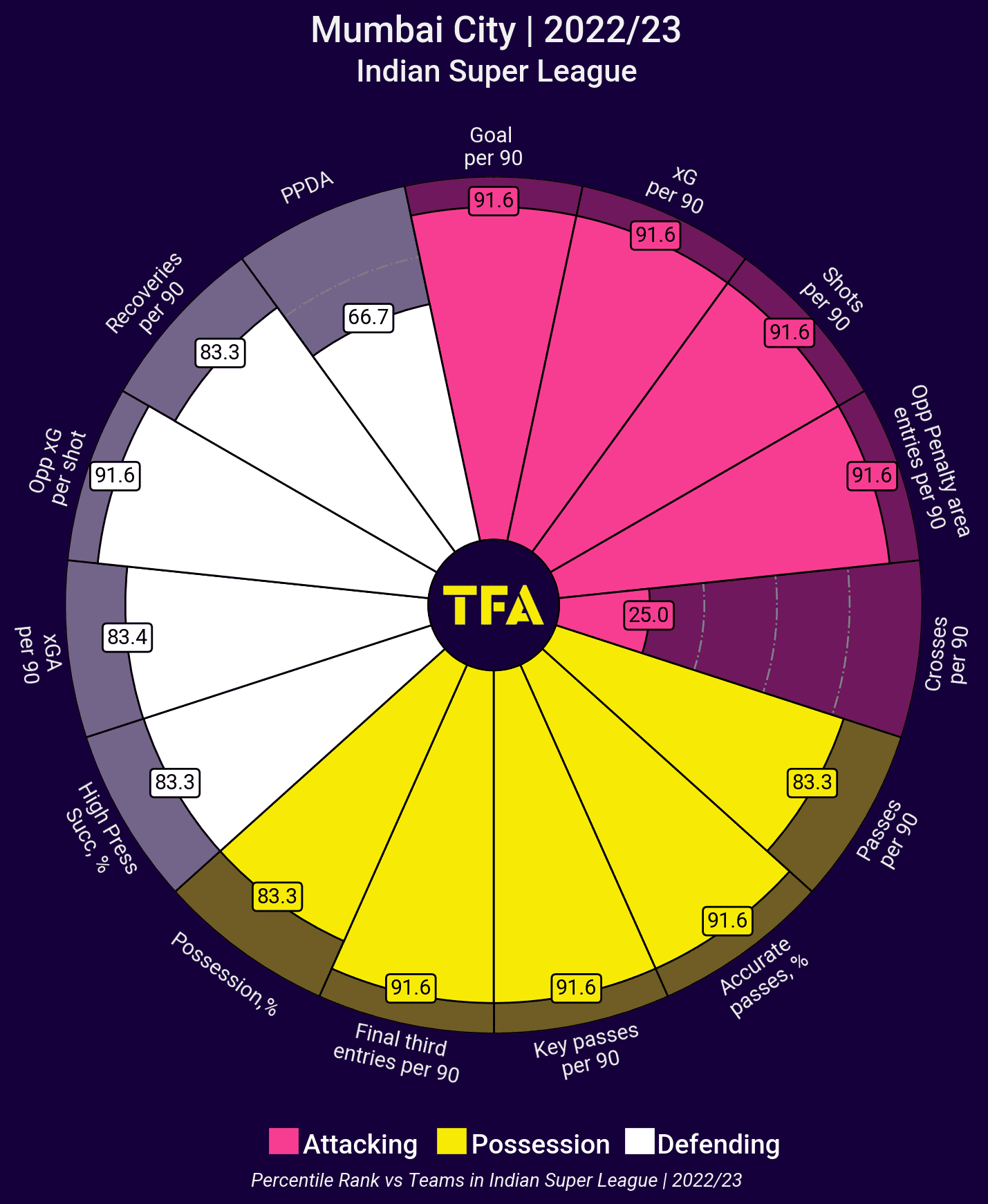
Just by looking at this, we can see that Mumbai have excelled in all key metrics of the game, which is very clearly shown in their results and position on the table. We’ll analyse in detail why their percentile in terms of crosses per 90 is very low in the upcoming sections of our analysis.
We can notice how they have a high percentile in terms of final third per entry per 90 supporting how they can create more goals scoring opportunities. Even in the defensive metrics, we can see how they’ve excelled in all aspects.
At the same time, it’s important to compare how the team has improved under Buckingham since his first season in charge.
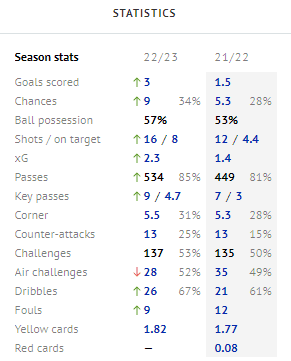
The first and foremost change that we can see is that the team has doubled their goals per 90 helping them convert their draws into wins. The team has been performing better in the final third season and looks to have more control over the game.
In the upcoming sections, we’ll see how Mumbai has been able to achieve these numbers and what tactics influenced their performance.
Attacking and creativity
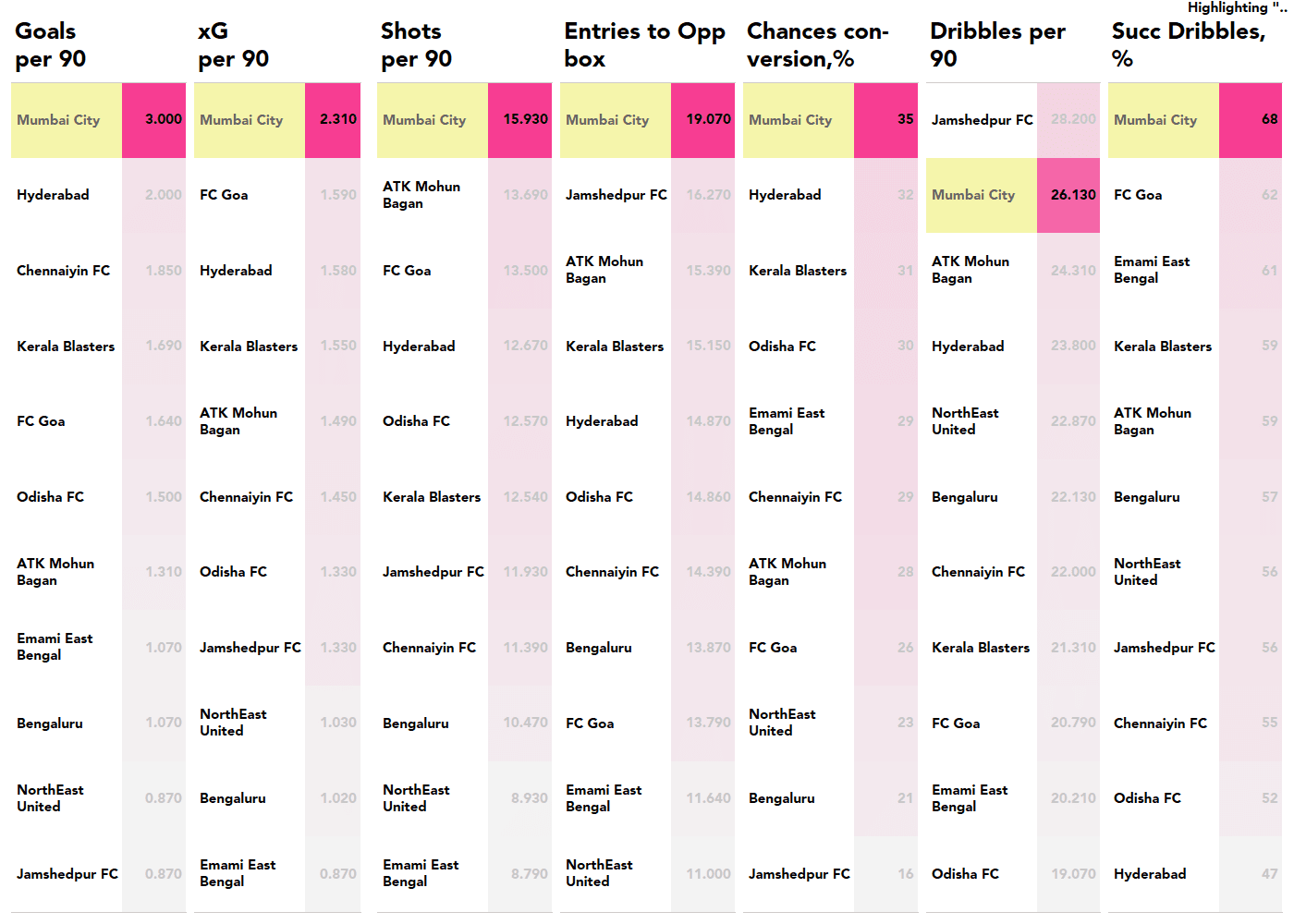
The benchmark is to give an idea of how Mumbai are performing in terms of attack concerning the other teams in the league and by the look of it, we can pretty much conclude that Mumbai have been the best attacking side this season.
In one of my scout reports in June, I wrote about Greg Stewart — one of the signings of the season for Mumbai — and he’s proven to be the key attacking outlet of the team. Mumbai prefer a 4-3-3 formation in the majority of the games with Stewart starting in an LCM position, but as the game progress, they shift into a 4-2-3-1, allowing Stewart to become the central attacking midfielder.
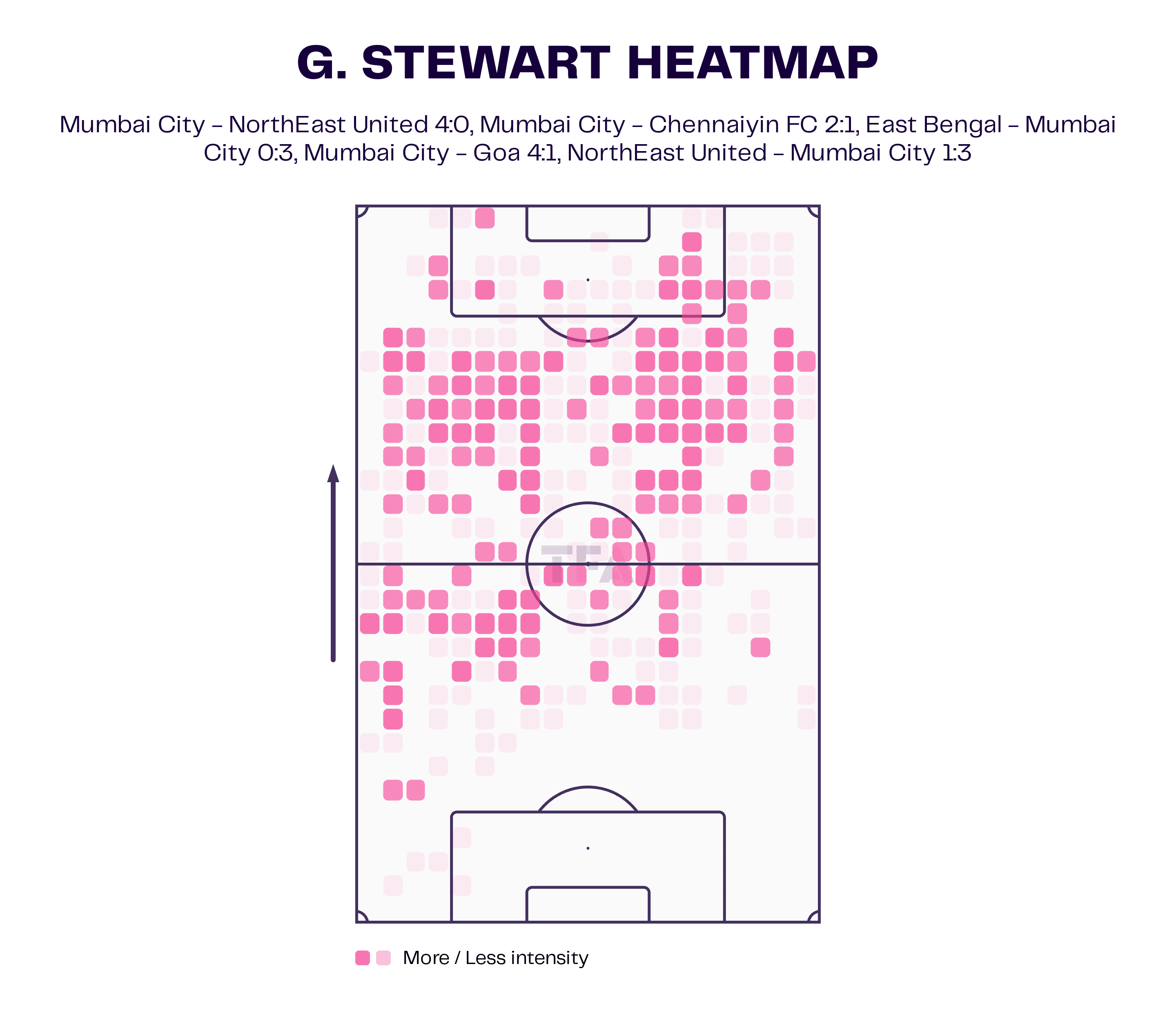
This heatmap of Stewart is from Mumbai’s last five games where they lined up in a 4-3-3 formation. We can notice how he has occupied the central zone and drives the team’s attack. By driving Stewart to the middle, Buckingham drains out the best from the attacking midfielder. With two of the fastest wingers in the league on their side, Stewart can keep creating threats continuously in both the flanks.
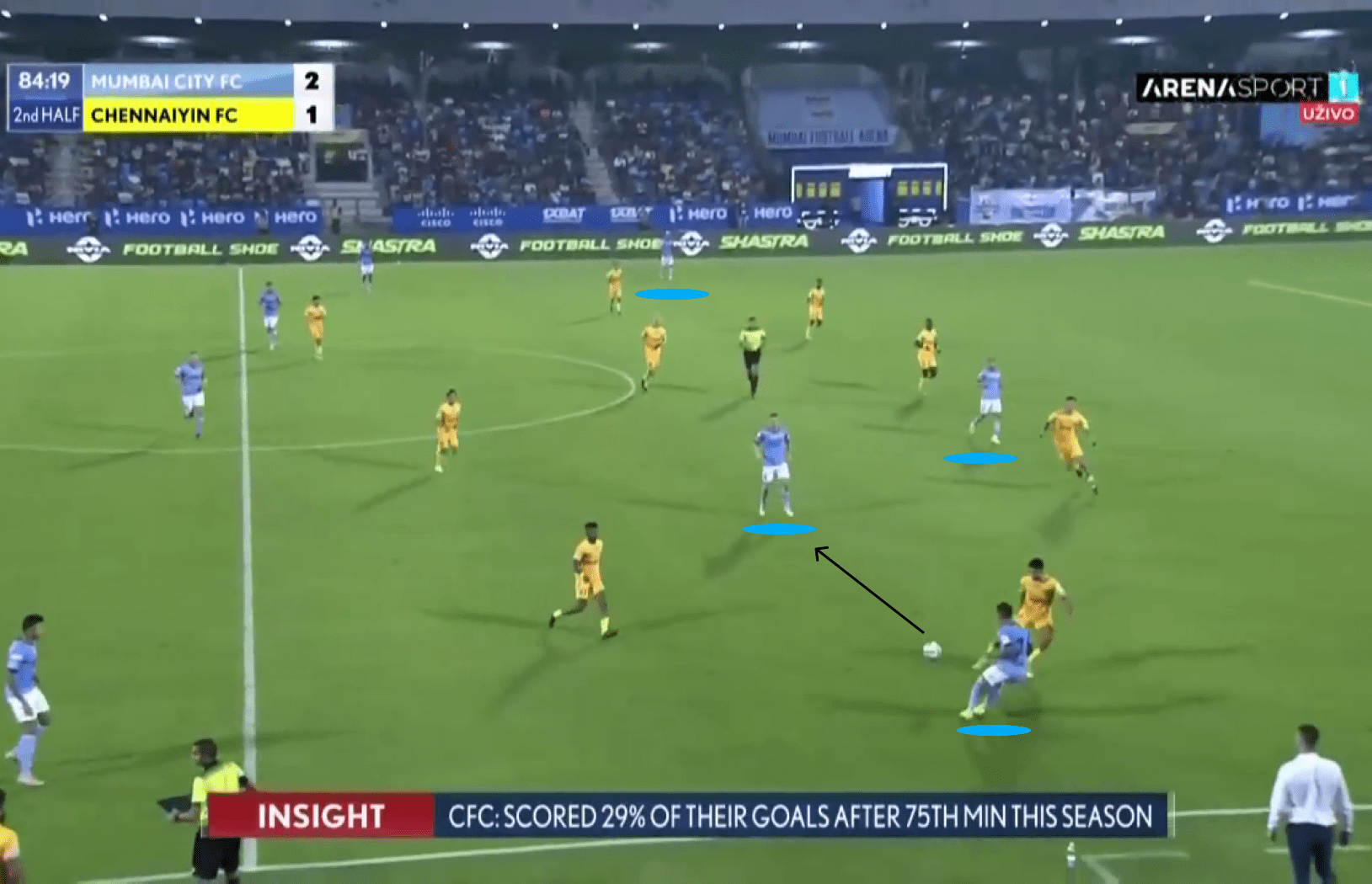
By making sure he’s available in the centre, Stewart who possesses great vision and decision-making can bring out the best in his team. It would be right to say that the attackers and Stewart complement each other and are perfectly in sync at all times of the game.
Stewart averages 1.96 through passes per 90 and 1.61 smart passes per 90, both second-highest in the league for players who have played more than 700 minutes this season. Both being a metric to evaluate the creativity of a player, it’s obvious he’s the driving force in terms of creating chances for the team.
Another common trait to be noticed in how Mumbai play is their runs in the final third. On many occasions, we can see Jorge Pereyra Díaz and Stewart making cross runs to confuse the defenders when the balls are carried closer to the penalty area.
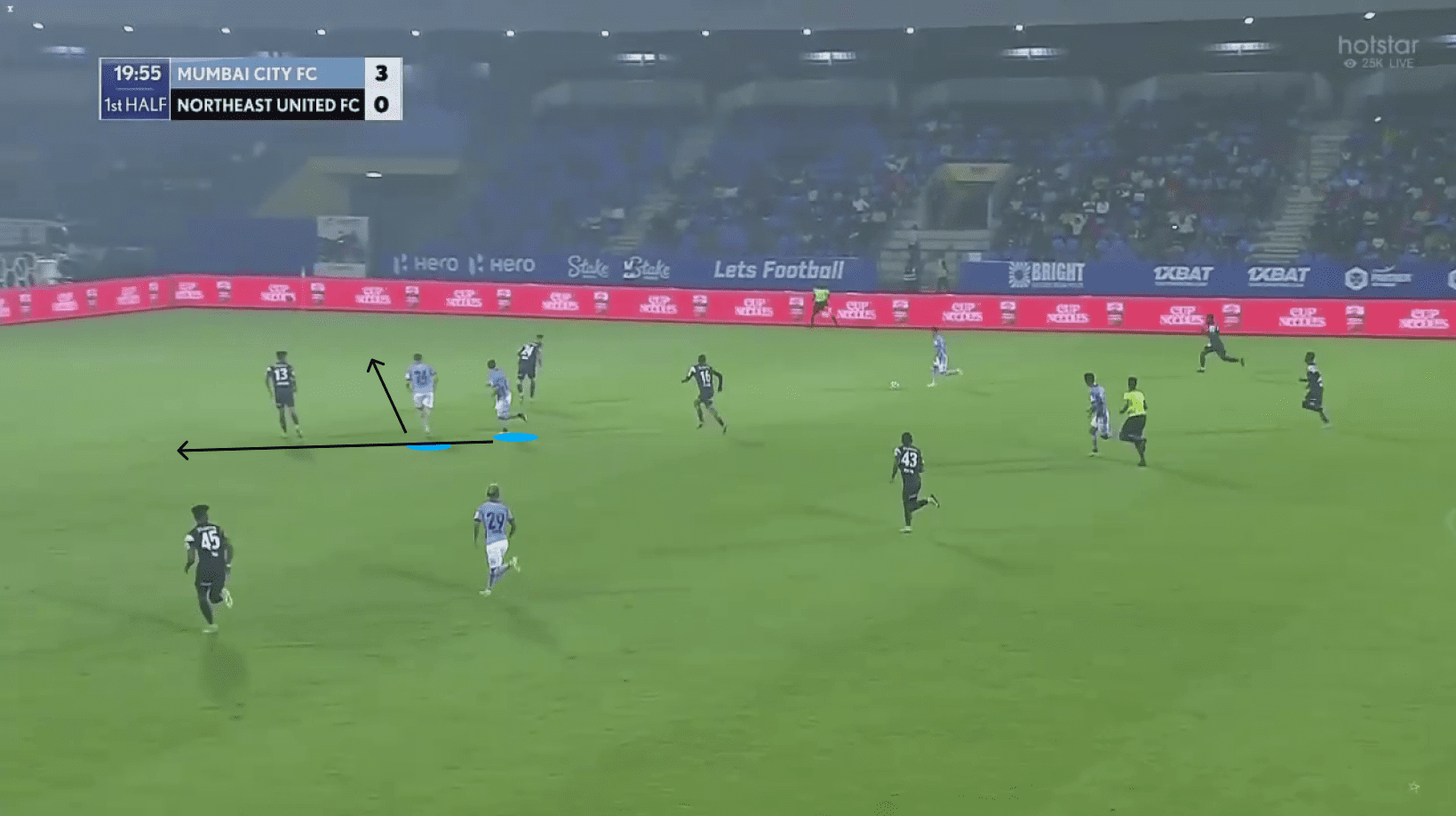
Now this simple run in front of the goal puts so much pressure on the defenders and also creates spaces for the winger to pass into. Another key tactic that I believe the coach has implemented is for the players to create their own spaces than try to occupy the ones existing.
In the matched image, we can see how Diaz moves to the flanks to exploit the space. Now the defender marking Diaz has to either run along with Diaz or stay with Stewart. In the latter case, Diaz receives the ball without any pressure but if the defender decides to stick to Diaz, he lets Stewart run freely towards goal.
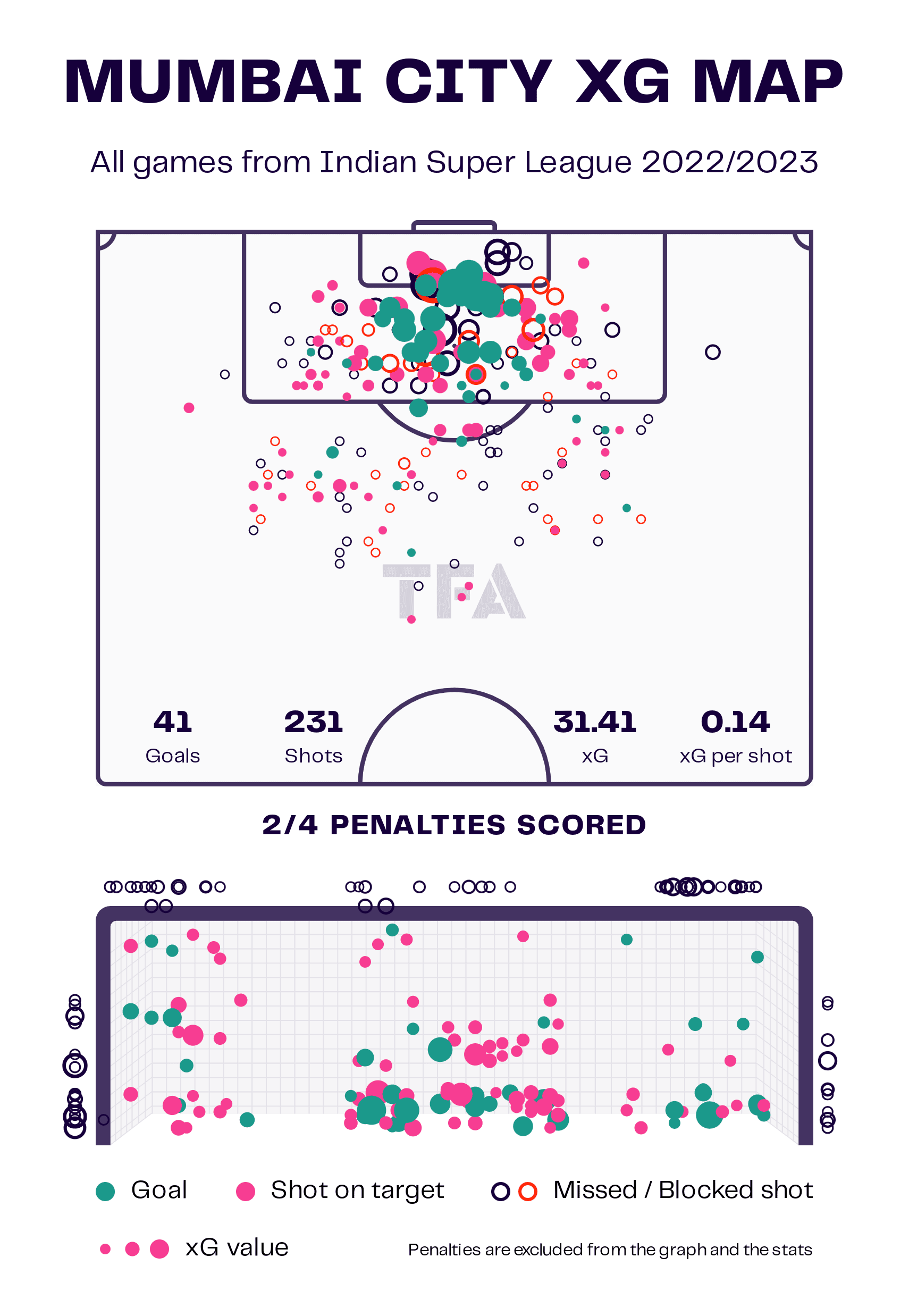
From the xG map of Mumbai for this season, we can see they’ve considerably outperformed their expected goals, but it’s also important to notice how the majority of their goals are shot from in and around the six-yard box from the same zone. I’ll be explaining how they get to this situation in the next section of this piece.
Passing and progression into the final third
Before jumping deeper into this section, we shall do our custom benchmark analysis to get an overview of how they place in this phase of the game.
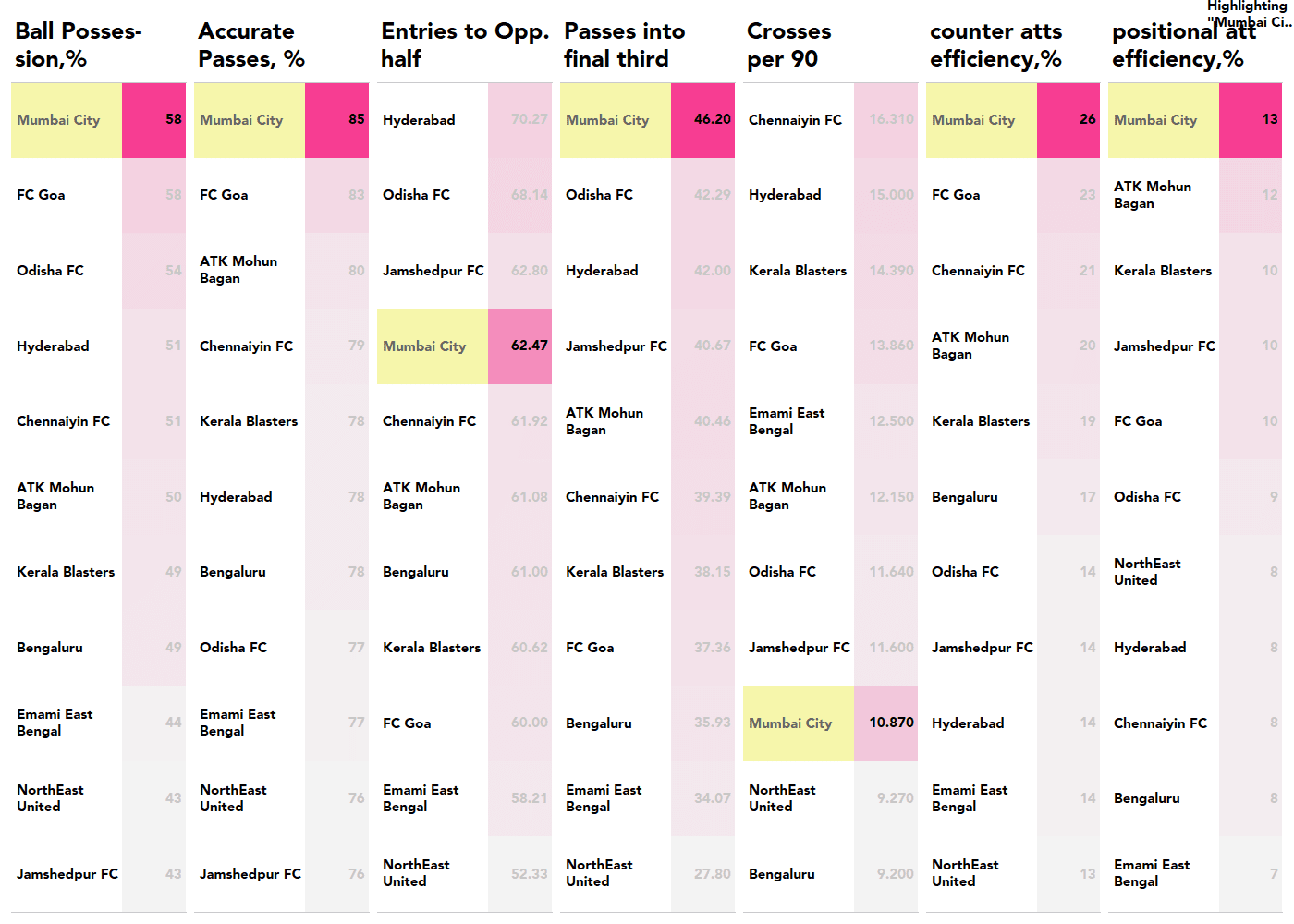
From the passing metrics benchmark, we can see that Mumbai again excel in most of the metrics but fall a bit short in terms of entries to the opponent’s half and crosses per 90. The fall in entries to the opponent half isn’t a major concern as it explains how careful they are in their progression. The team has 46.20 entries into the final third, which is the highest which explains that they are careful to enter the opponent’s half and when they do, they always make it to the final third. The drop in crosses per 90, will be explained later in this section.
So first we’ll begin with build-up from the back. When building up from the back Mumbai’s captain Ahmed Jahouh is acting as a pivot and linking the defensive and offensive line in the play.
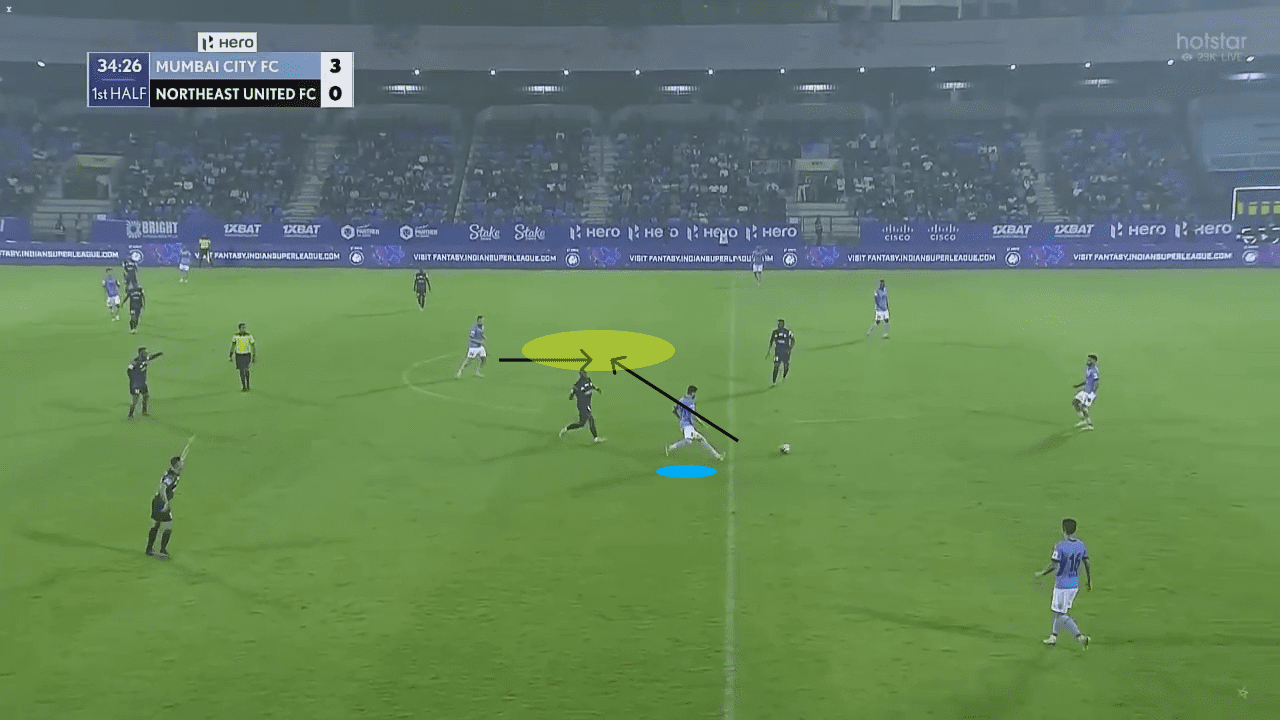
With his quick decision-making, Jahouh can spot spaces and quickly progress the ball to the final third. If given enough time and not pressurised properly, he is capable of sudden long and through balls and takes the defenders by surprise.
This season, Mumbai has taken the most advantage of its players. Understanding the strengths of the wingers they have, the majority of the progression of the team happens in the flanks
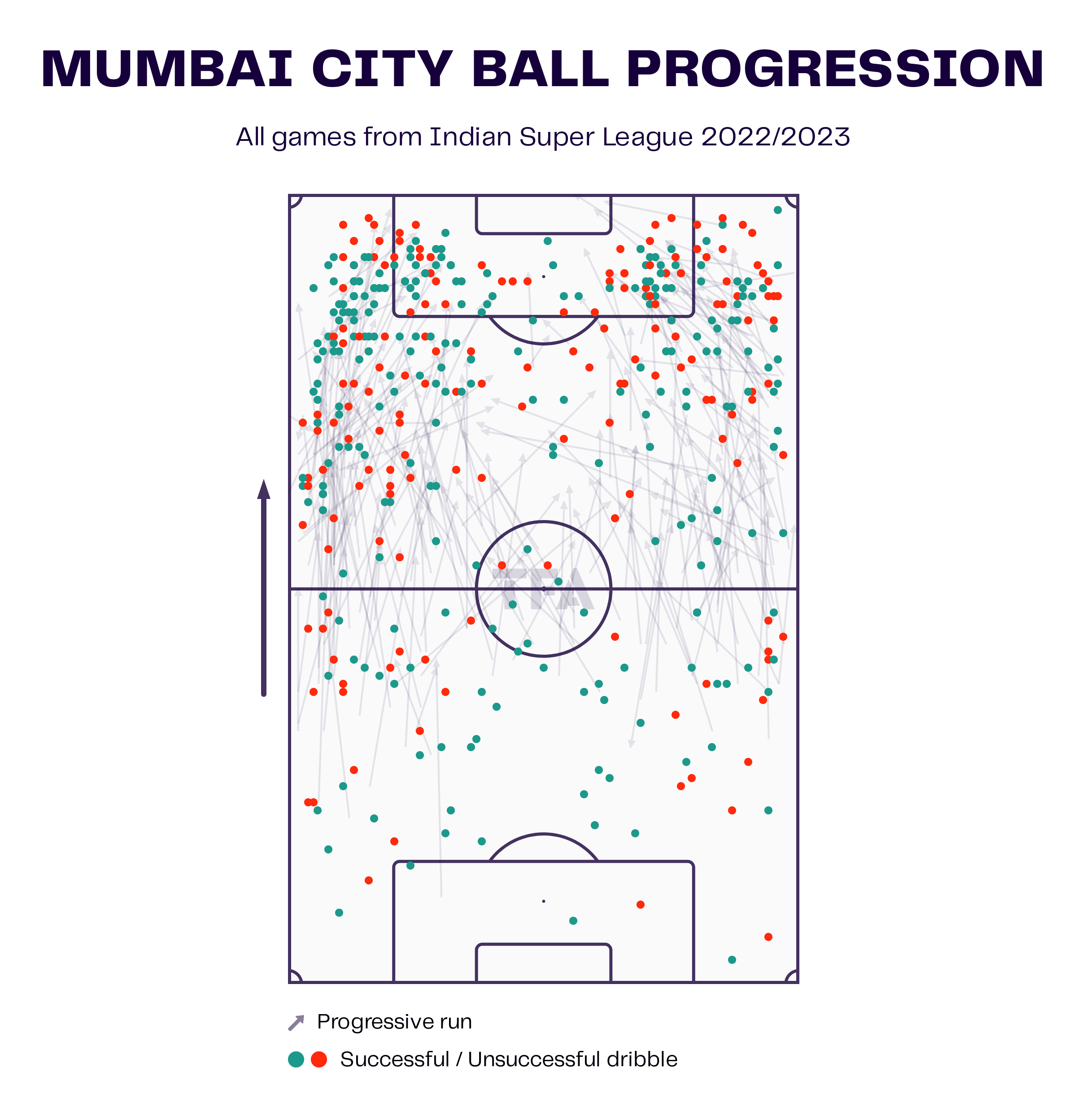
I would use the above ball progression visualisation to support my previous statement of how a majority of their ball progression happens on the flanks. With Bipin Singh and Lallianzuala Chhangte, two of the best dribblers in the league, Buckingham has no problem in progressing the ball via the wide areas.
Another tactical change this season is how direct the team has been in the final third. This is the main season why the team is lying low on crosses when compared to the rest of the league.
In the visualisation of Mumbai’s progression, we can notice how a majority of their progressive runs from the flanks finish inside the penalty area. Buckingham knows how good the dribblers on his team are, and he gives them the freedom to experiment in the final third. Both Bipin (4.95) and Chhangte (5.38) have the highest touches in the penalty area per 90 this season, explaining how frequently they get into the opponent’s box.
Once in the final third, there are more cut-back passes to the striker than crosses, which is why we can see Mumbai on top of dribbles and low on crosses per 90. This way, the attackers also get time to move into the penalty area.
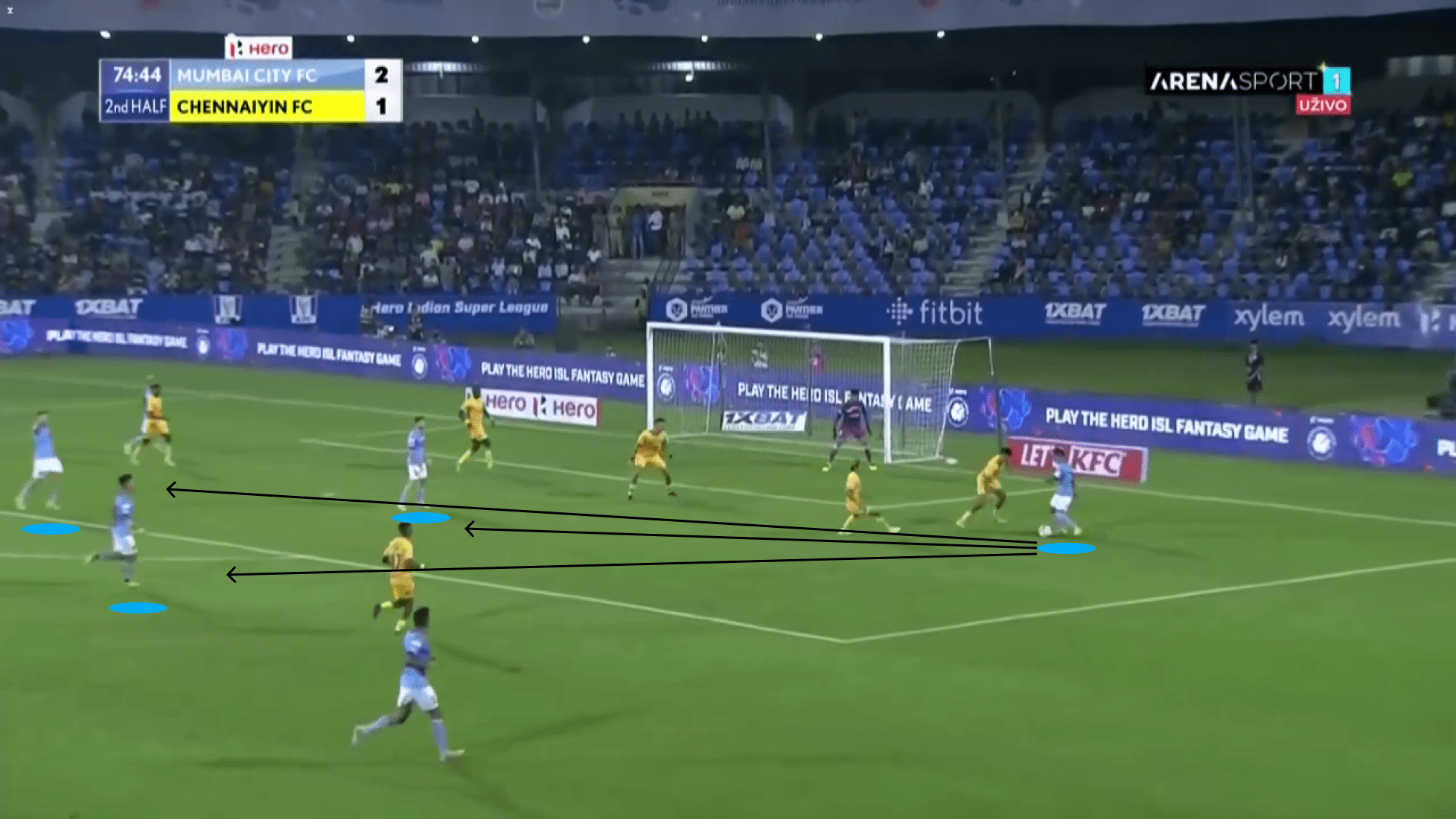
In the match image, we can see how Mumbai’s players are offering so many positions on the field while the winger is waiting to make a cut-back. They pretty much have positioned in all possible zones in the penalty area and also have the defensive midfielders push up to win the second balls and make high recoveries. This is another tactic we can see which explains why the majority of their goals come from similar positions around the six-yard box.
Defensive duties
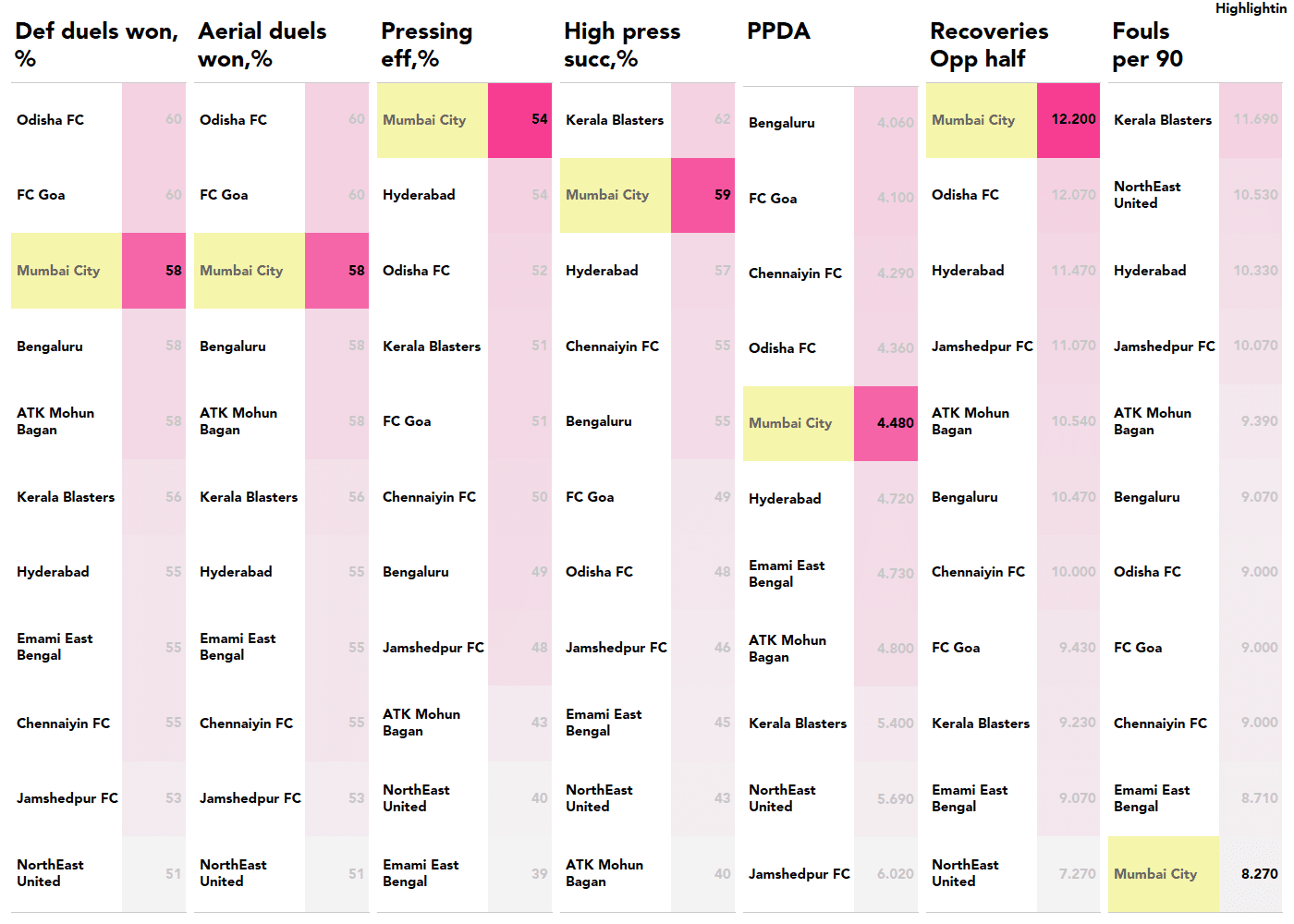
To obtain an initial idea of their defensive performance, we can see they are ranked third in the league in terms of winning duels. In terms of ball recovery and pressing, they are at the top — pretty much indicating their nature of behaviour when they lose the ball. It’s also vital to notice how Mumbai is the team with the least fouls per 90, perhaps shedding some interesting light on their character.
Mumbai in general like to press high and make recoveries right up front. They do this by applying pressure on the ball possessor and by also marking all the free players in the surrounding.
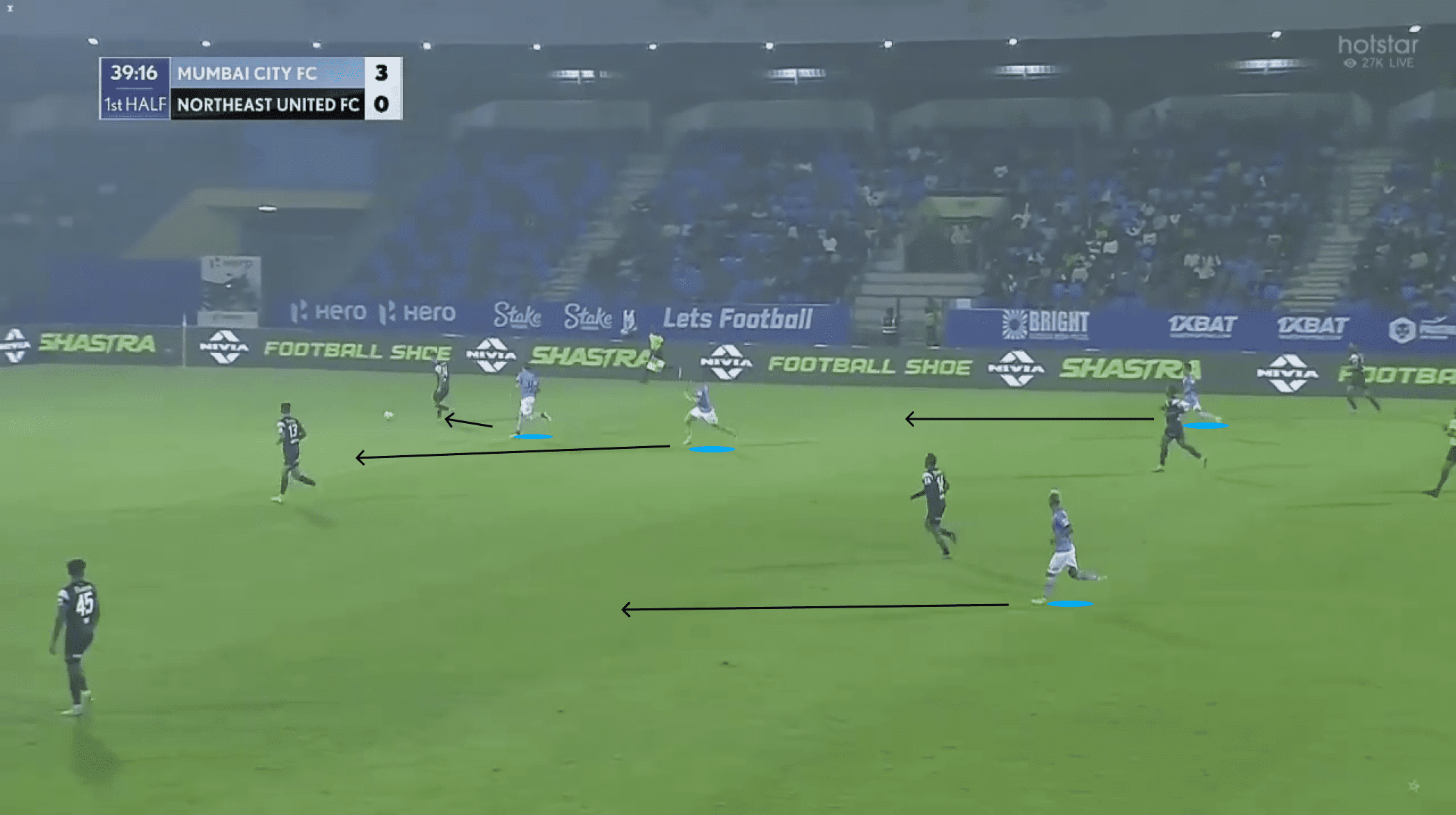
We can see how a Mumbai player is closing down the defender while the other players are sprinting to mark the free players to win the ball back despite leading by three goals in just 39 minutes. This shows how the team stick to the plan and remain hungry for the ball irrespective of the match situation.
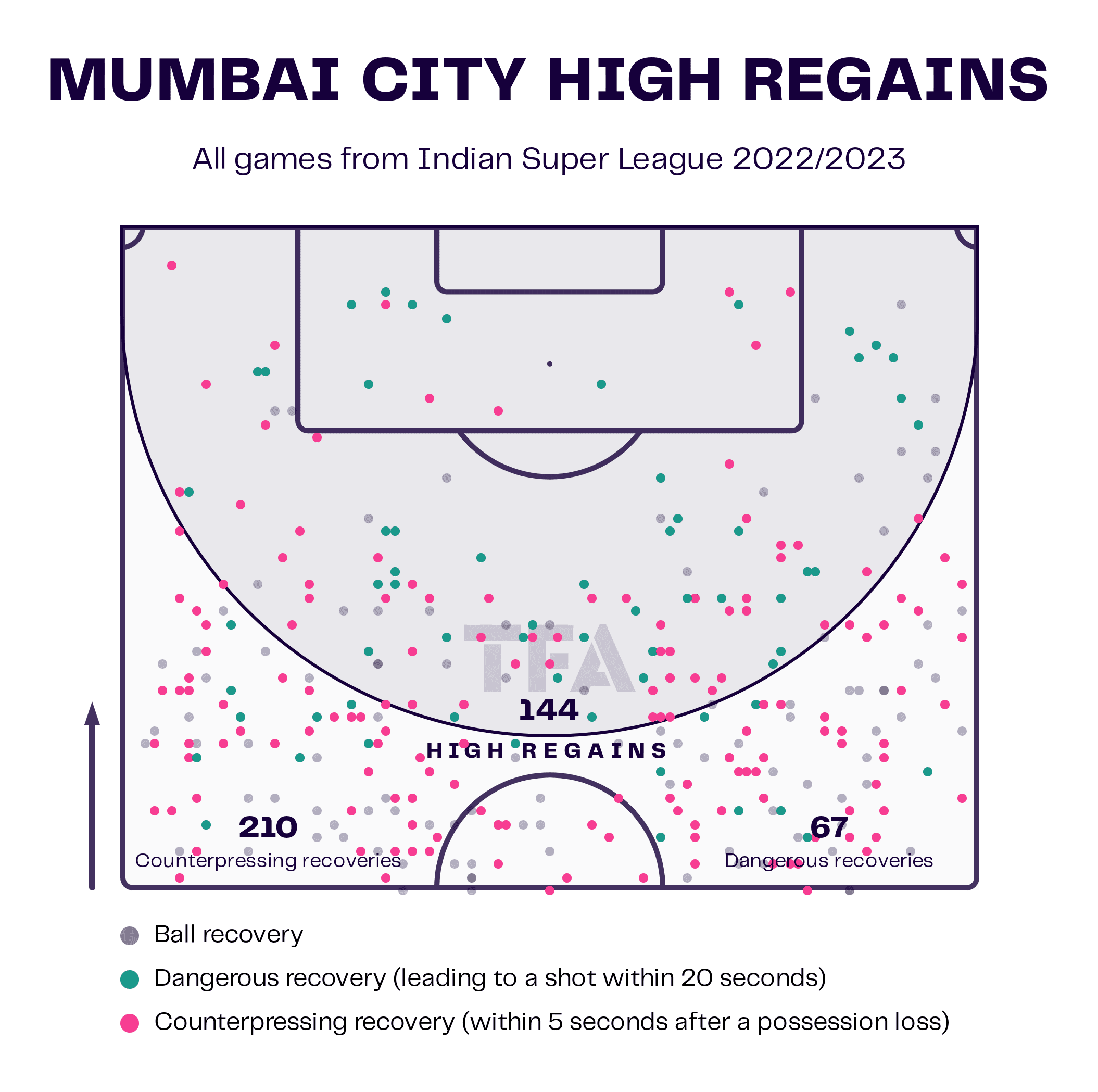
We can notice how Mumbai have 144 high recoveries, among which 67 were dangerous recoveries. They have also made a lot of counterpressing recoveries in the final third with quite a few of them coming from inside the penalty area. Winning the ball up-front has worked for Mumbai very well and they’ve significantly reduced the pressure on their defenders this season.
If the opponents manage to escape the press, Mumbai quickly shifts to a flexible 4-1-4-1 where the single defensive midfielder role is played by Jahouh, who with his excellent game-reading ability can win the ball back quickly.
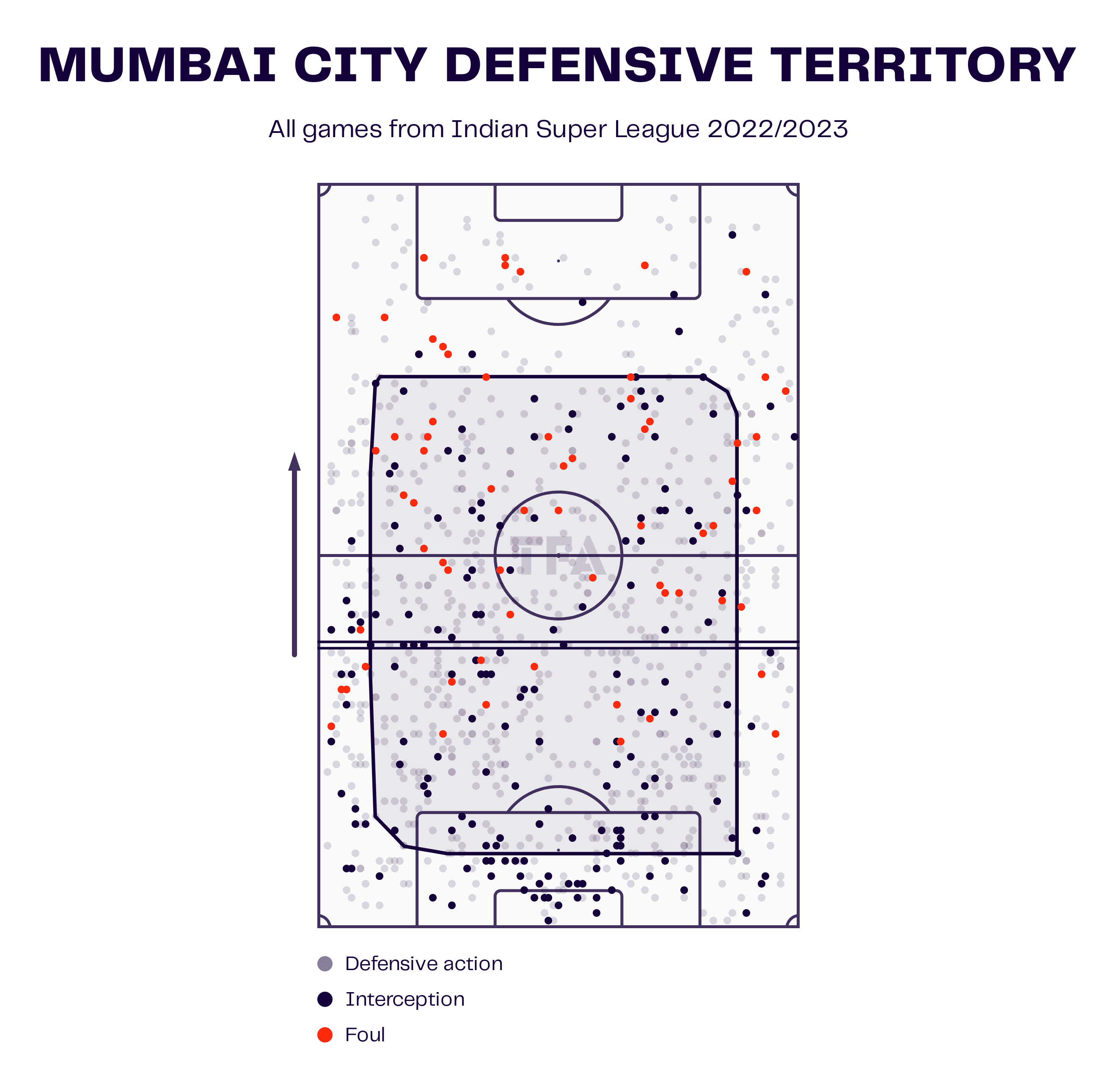
The key tactic in the defensive phase of the game is to win the ball back as early as possible and as high as possible. This way they get to reduce the potential threat. From their defensive territory, we can notice how high their average defensive line is, which is almost close to the middle.
By controlling the game and winning the ball quickly, Mumbai has significantly been able to reduce threat this season. With a flexible 4-1-4-1, while defending, they are also able to keep both the flanks and the centre compact and make it hard for the opponents to progress.
Conclusion
On the whole, we can see how minor tactical changes in the way they play have benefitted Buckingham’s men in a major way. Mumbai show positive signs and look promising for the Asian Champions League if they qualify, which they most likely will. Apart from great tactics, I think a key reason behind their performances this season has been the coach’s knowledge of and attention to detail with his players. He has drawn out a perfect tactical plan in such a way he’s been able to implement his strategy and create a structure that suits the players’ strengths.
With the former champions following behind with a six-point difference, we can expect Mumbai City to win the league this season. But the route to the finals will be an interesting tactical battle — most likely against Hyderabad FC. Irrespective of where they finish this season, Buckingham has earned respect and trust among the fans which could deliver a fairytale finish if he goes on to win both the league and the championship.





Comments